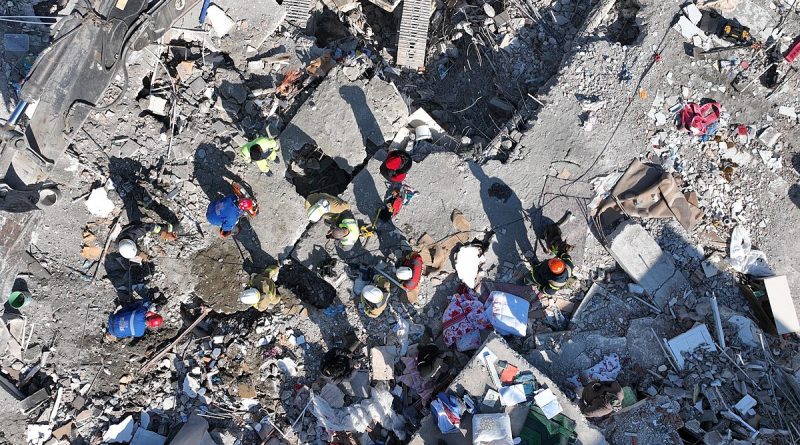A Natural Disaster vs. Man-Made Building
Melissa Myrtaj
Staff Writer
On February 6, a 7.8- magnitude earthquake hit Türkiye and Syria with more than a 100 km rupture between Anatolian and Arabian planes, according to BBC News. Reuters reports that the epicenter of the earthquake was about 26 km east of Nurdagi, Türkiye and radiated northeast to central Türkiye and Syria. Eleven minutes after the first hit, there was a 6.7-magnitude aftershock followed by a 7.5- magnitude quake hours later, and an additional 6.0 spasm in the afternoon, adds Reuters. One of the deadliest earthquakes of the decade, the disaster has civil defense members and rescue teams working hard to compensate for the lack of infrastructure and equipment necessary to handle the quake’s aftermath.
In Syria, residential complexes built for people who were displaced within Syria were ruined by the earthquake, according to Al Jazeera. Complexes in Salqin and Harem in the Idlib countryside and al-Atareb and Jenderez in Aleppo, complexes in the opposition-controlled region, were destroyed. The quick building collapses in the Idlib and Aleppo countrysides were partly due to the attacks the area has endured over the past 10 years, Saria Bitar, a civil engineer and head of Hathi Hayati Volunteering Group in the northern city of Idlib, told Al Jazeera. Bitar explained that the buildings’ infrastructure in Aleppo was not strong enough for the earthquake, especially after suffering military strikes under Assad’s regime.
However, the quick collapses are rooted in the infrastructure of the region not accounting for natural disasters in the building processes of the residential complexes. Al Jazeera further explains that the complexes in northwestern Syria lacked technical and engineering regulations like the absence of a sufficient number of metal rods in the buildings’ foundations, as well as not digging the foundations deep enough to ensure that they will be sturdy. The structures that survived the earthquake were buildings whose construction was supervised by engineers who aligned their work with international criteria.
The failure of infrastructure led to the collapses, but the absence of the equipment necessary to save people from the fallen buildings has resulted in further deaths. The countries do not have the machinery to lift the collapsed ceilings, especially in buildings that were four or five floors high. Rescue teams and locals worked two days straight lifting roofs to save families. Abu Muhammed, a resident in Jinderes, Syria, told Al Jazeera that dozens of families could have stayed alive if heavy equipment had been available, but they all died due to the extreme cold and being cut off from food and water. This earthquake is something the countries did not plan for and has created irreversible damage to the families in the region.
As for Türkiye, Al Jazeera reports that President Recep Tayyip Erdogan acknowledged the shortcomings of his government’s response, saying, “In the first days, we were not able to conduct work as efficiently as we wanted to in Adiyaman, for reasons such as the destructive impact of the tremors, adverse weather and challenges due to the damaged infrastructure.” He added, according to BBC News, “For this, I ask forgiveness.”
In Türkiye, like in Syria, the buildings did not comply with government standards, said Eyup Muhcu, president of the Chamber of Architects of Türkiye. According to the Associated Press, Builders tend to use lower quality materials, fewer professionals to oversee projects, and avoid regulations to cut costs. Also like in Syria, the government’s aid in these areas does not reach where it needs to in order to combat the disaster. The United Nations has said at least 1.5 million people have been made homeless in southern Türkiye, with more than 500,000 homes needing to be rebuilt, reports Al Jazeera. BBC News adds that where the aid does reach, it does so slowly, as Adiyaman resident Mehmet Yildirim explains, “I did not see anyone until 2:00 pm on the second day of the earthquake.”
As of February, Al Jazeera reports that more than 41,000 people have died in Türkiye and about 5,800 in Syria. This is the irreversible damage from a natural disaster the Turkish and Syrian governments could have relieved by following proper guidelines instead of focusing on relieving the costs at the time. This is an opportunity for the governments to establish a new norm for infrastructure, implement active policy reform to close the gaps in unsupervised construction, and fix the buildings that do not meet government or international standards. This can be the catalyst to change policy and take lead in preventative measures to secure the safety of the people living in their country and to ensure the governments are ready to be there quickly and adequately to provide.
Image courtesy Wikimedia Commons


